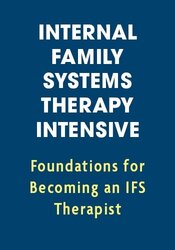What Happens When the Internal System is in Conflict

When a clientŌĆÖs internal system is in conflict, it often means that different parts are at odds with one anotherŌĆömanagers, exiles, and firefighters may be engaging in internal battles that manifest as emotional distress, self-sabotage, or dysfunctional behaviors. As an IFS therapist, the goal is to help the client understand the dynamics at play, ease the conflict, and work toward healing and integration of these parts.
HereŌĆÖs what you need to do when working with clients whose internal systems are in conflict:
HereŌĆÖs what you need to do when working with clients whose internal systems are in conflict:
1. Acknowledge and Validate the Conflict
- Listen with Curiosity: When a conflict is evident, the first step is to validate that the internal conflict is real and important. You should avoid minimizing or rushing to solve the conflict. Instead, listen with curiosity and compassion to all parts involved.
- Create a Safe Space: Ensure that the client feels safe enough to explore and express the conflict. For some clients, internal conflict can feel overwhelming or shameful, so creating a space where no part is judged is critical.
2. Help the Client Unblend from the Parts
- Unblending is the process of helping the client separate from their parts so that they can observe and interact with them, rather than being consumed by them. When parts are blended, your client may feel that their experience (e.g., anxiety, anger, sadness) is all they are.
- Encourage Self-Leadership: Remind your client that their Self (the wise, compassionate, and centered part of them) is the one leading the process. By fostering your clientŌĆÖs connection with their Self, you create a neutral presence that can facilitate dialogue between conflicting parts.
3. Identify the Parts Involved in the Conflict
- Clarify the Conflict: Help your client identify which parts are in conflict. This could involve managers trying to maintain control and protect the client from vulnerability (e.g., anxiety, sadness, fear), while other parts (e.g., exiles) are urging your client to express and process painful emotions.
- Understand Each PartŌĆÖs Positive Intent: In IFS therapy, every part, even if it is acting destructively, is seen as having a positive intention. For example, a firefighter might engage in self-destructive behavior to numb overwhelming pain (from an exile). Managers might be controlling to prevent the client from feeling vulnerable or being hurt. ItŌĆÖs important to help your client see that each part is attempting to fulfill a need or protect them, even if the methods are maladaptive.
4. Facilitate Communication Between the Parts
- Invite Dialogue: Encourage the conflicting parts to "speak" to each other. This can be done by guiding your client to "speak from" or "speak to" their parts, creating a space where each part can express its needs, fears, and desires. For instance, you might ask: ŌĆ£Manager, what are you trying to protect the client from?ŌĆØ and then ask, ŌĆ£Exile, what do you need to feel safe?ŌĆØ
- Ask for Compassionate Listening: Encourage the parts to listen to each other with empathy. Acknowledge that these parts have been in conflict for a reason, often to protect the client from emotional pain or distress. The goal is to foster understanding between the parts, rather than forcing a quick resolution.
5. Work with Protectors First (Managers and Firefighters)
- Respect the ProtectorsŌĆÖ Role: Managers and firefighters often engage in conflict with exiles because they believe that the exilesŌĆÖ emotions are dangerous or overwhelming. ItŌĆÖs important to work with these protectors first, as they are often the ones who are more present and accessible.
- Invite the Protectors to Relax: Gently ask the protectors (especially managers) to step back, slow down, or ease their vigilance. This doesnŌĆÖt mean removing their protective function but inviting them to trust that the Self can handle what might have felt too dangerous before. Once the protectors feel heard and reassured, they may be more willing to allow the exiles to process their pain.
6. Help the Exiles Express and Release Their Pain
- Create Safety for Vulnerable Parts: If an exileŌĆÖs pain is at the root of the conflict, work with the client to create a safe environment for the exile to express itself. This might involve revisiting past memories of trauma or emotional pain, allowing the exile to feel seen and heard.
- Unburdening: Help the exile let go of the emotional burdens theyŌĆÖve been carrying (e.g., fear, shame, guilt). This process often involves the exile releasing distorted beliefs theyŌĆÖve formed about themselves (e.g., ŌĆ£IŌĆÖm not worthyŌĆØ or ŌĆ£IŌĆÖm brokenŌĆØ). The exile may then be able to heal and reintegrate into the system, no longer needing to carry the same pain or distortions.
7. Support the Parts in Finding New Roles
- Negotiate New Roles for Protectors: Once the exiles are heard and unburdened, managers and firefighters may feel less need to be overactive or extreme in their protective roles. The therapist can help these parts find new ways to function that are less rigid or damaging. For example, a manager who previously controlled the clientŌĆÖs emotions might agree to relax its vigilance, knowing the exile is no longer overwhelmed by their pain.
- Encourage Internal Cooperation: Facilitate the development of a more cooperative internal system. When parts understand each otherŌĆÖs roles and are allowed to function from a place of balance and clarity, the internal system can work together more effectively.
8. Reintegrate and Foster Harmony
- Reconnect the Parts to the Self: After the dialogue and unburdening work, encourage your client to help all parts return to a more harmonious internal system under the leadership of the Self. This might mean integrating the previously exiled parts with the other parts in a way that creates a more balanced internal environment.
- Create Internal Cooperation: The aim is to create a scenario where parts cooperate with each other, instead of being in conflict. This could involve helping the manager recognize that the exileŌĆÖs pain can be handled in a safe and controlled way, and that the firefighterŌĆÖs need to numb the pain can be alleviated by healing the exile directly.
9. Provide Ongoing Support for Internal System Health
- Teach the Client Self-Leadership: Once the conflict has been worked through, itŌĆÖs important to continue to foster the clientŌĆÖs connection with their Self. Encourage the client to check in with their internal system regularly, notice when parts are blending, and maintain an attitude of curiosity and compassion toward all parts.
- Monitor the Balance: Keep an eye on whether any parts begin to dominate or become out of balance again. Conflicts can resurface, especially when new stresses arise, so continued self-awareness and check-ins with the internal system are important for long-term integration.
10. Respect the ClientŌĆÖs Pace
- Be Patient: Conflict resolution in IFS therapy is often a slow and gradual process. Some parts might resist change, and clients might need time to integrate what theyŌĆÖve learned. ItŌĆÖs important to respect the clientŌĆÖs pace and not force any part into a change it isnŌĆÖt ready for.
- Revisit Conflict When Needed: Some conflicts may resurface in later sessions. ThatŌĆÖs okayŌĆöhealing is often non-linear. When conflict reappears, you can help your client revisit the dynamics with fresh perspectives and tools.
3-Day Internal Family Systems Therapy Intensive: Foundations of Becoming an IFS Therapist

IFS therapy is one of the fastest growing treatment approaches in the field ŌĆō because it works! ItŌĆÖs a non-pathologizing, evidence-based method uniquely designed to work directly with the clientŌĆÖs internal world ŌĆō accessing protective mechanisms, healing deeply held wounds, and creating transformational change that lasts. And now you can take your first step in the journey to become an effective IFS therapist. This is a rare opportunity to learn IFS therapy directly from one of the leading experts in the field, Solo Lead Trainer, Elizabeth Taeubert.
Meet the Expert:
Elizabeth Taeubert, LCSW, RN, MS is a lead trainer for the IFS Institute and has led IFS therapy trainings both domestically and internationally. She has worked extensively with clients healing from PTSD and complex trauma. Additionally, she provides individual and group consultation to IFS therapy clinicians. Elizabeth holds an MSW from George Williams College in Aurora, Illinois and an MS from DePaul University in Chicago.
Learn more about her educational products, including upcoming live seminars, by clicking here.
Learn more about her educational products, including upcoming live seminars, by clicking here.



